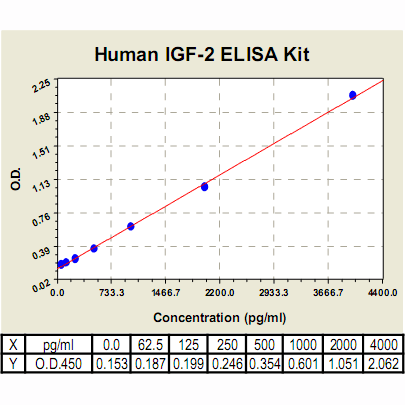IGF-2 ELISA Kit, Human |
 |
BACKGROUND Insulin-like growth factor II (IGF-II) plays a key role in mammalian growth, influencing fetal cell division and differentiation and possibly metabolic regulation. The mature 67 amino acid peptide shares sequence homology with both insulin and IGF-I. The liver is the main endocrine source of IGFs, but autocrine/paracrine activity is found in most tissues. IGF-II binds to two types of receptors. The IGF-I receptor that is a tyrosine kinase and closely related with the insulin receptor and the IGF-II/mannose 6-phosphate receptor that is identical with the cation-independent mannose 6-phosphate receptor. The mitogenic and metabolic actions of IGF-II are propagated by the IGF-I receptor. In contrast, the receptor, that target lysosomal enzymes from the Golgi apparatus or the plasma membrane to the lysosomes, mediates the rapid internalization and degradation of IGF-II.1 IGF-II is expressed at high levels during fetal life and it is a major growth factor for the fetus in rodents. The developmental profiles and tissue distribution of the IGF-I and the maternally imprinted receptors both parallel that of IGF-II. In this scenario IGF-II promotes the growth of the embryo through the IGF-I receptor, whereas the receptor balance the activity by controlling the extracellular level of IGF-II. Binding proteins may both localise IGFs to the receptors and regulate their activities.2
The IGF-II gene is coupled to the insulin gene and paternally imprinted. Multiple IGF-II mRNAs with identical coding regions and 3′ untranslated regions (UTRs) but different 5′ UTRs are generated from 3 promoters. Relaxation of IGF2 imprinting occurs in the Beckwith–Wiedemann syndrome of somatic overgrowth, sporadic Wilms' tumour and a number of other cancers. In the general adult population, the IGF2-INS gene cluster may also influence body weight, in which case IGF-II function could become a target for therapeutic intervention in obesity.3
The IGF-II gene is coupled to the insulin gene and paternally imprinted. Multiple IGF-II mRNAs with identical coding regions and 3′ untranslated regions (UTRs) but different 5′ UTRs are generated from 3 promoters. Relaxation of IGF2 imprinting occurs in the Beckwith–Wiedemann syndrome of somatic overgrowth, sporadic Wilms' tumour and a number of other cancers. In the general adult population, the IGF2-INS gene cluster may also influence body weight, in which case IGF-II function could become a target for therapeutic intervention in obesity.3
REFERENCES
1. Nielsen, F.C. et al: Prog. Growth Factor Res. 4:257-90, 1992
2. Sandberg, A.C. et al: Neurosci. Let. 93:114-9, 1988
3. LeRoith, D. & Bondy, C.: Growth Factors and Cytokines Health Dis. 1:1-26, 1996
2. Sandberg, A.C. et al: Neurosci. Let. 93:114-9, 1988
3. LeRoith, D. & Bondy, C.: Growth Factors and Cytokines Health Dis. 1:1-26, 1996
Products are for research use only. They are not intended for human, animal, or diagnostic applications.
Параметры
Cat.No.: | CL0379 |
Target Protein Species: | Human |
Range: | 62.5 pg/ml – 4000pg/ml |
Specificity: | No detectable cross-reactivity with IGF-1 |
Storage: | Store at 4°C. Use within 6 months. |
ELISA Kits are based on standard sandwich enzyme-linked immunosorbent assay technology. Freshly prepared standards, samples, and solutions are recommended for best results.
Документы
Информация представлена исключительно в ознакомительных целях и ни при каких условиях не является публичной офертой








